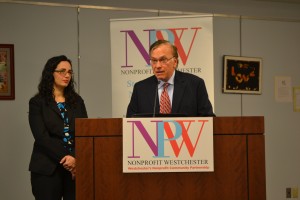Study: Nonprofits largest employer in Westchester
A new study shows nonprofits employed more people in 2013 than any other single industry in Westchester County.
According to the results of a highly anticipated report conducted in part by Johns Hopkins, not-for-profit entities employed nearly 54,000 people last year, paying about $2.7 billion in wages. That employment level represents nearly three times as many workers as there are in the county”™s finance industry and four times as many as are in manufacturing.
“We”™ve always known nonprofits provide many essential services that are critically important,” said Joanna Straub, executive director of Nonprofit Westchester. “Now we know just how vital they are and how much they contribute to Westchester County.”

In an attempt to assert the importance of nonprofits to the Westchester County economy, Nonprofit Westchester announced the results of the $15,000 study recently in partnership with the Johns Hopkins Center for Civil Society Studies.
Straub said the study proves the vital role nonprofits play in the county”™s economy. Data for the study were collected from federal Form 990 filings and the Quarterly Census of Employment and Wages. The study was paid for by the Westchester Community Foundation, a nonprofit.
Straub said she hopes more business leaders and government officials will begin to consider nonprofits”™ interests more seriously, rather than as an afterthought. Several times in the past, the sector has been excluded from commissions and closed-door meetings about new initiatives to which it should have been invited, she said.
“We want a seat at the table,” Straub said. “We want to change the mindset surrounding nonprofits.”
The sector represents 13.6 percent of total employment in the county and contributed the greatest number of new jobs between 2003 and 2013, according to the report. Since 2003, local government employment has shrunk 9.6 percent. Employment in the for-profit sector has grown only 1.2 percent, compared with 8.4 percent growth in the nonprofit sector.
//
Much of that growth has come from elementary and secondary education, ambulatory health, nursing homes and colleges and universities.
More than 50 percent of all nonprofit jobs are in health services, 20 percent are in education and 11 percent are in social assistance.
The U.S. Bureau of Labor Statistics has historically combined all employment data to include both the for-profit and nonprofit sectors. As a result, the financial impact nonprofits make has been widely unknown, said Lester M. Salamon, director of the Johns Hopkins Center for Civil Society Studies.
“You don”™t get the respect that you deserve and you don”™t get the support you deserve,” Salamon told nonprofit leaders at a press conference in Greenburgh.
“(The impact) is there but it”™s buried in the data,” he said. “Data systems are the lens that we see the economy in and unfortunately they”™ve been a blur.”
Salamon said he”™s helped compile similar reports for at least two other regions that have gone on to use the data to mobilize the nonprofit sector and advocate for stronger support.
While nonprofit employment has grown, the sector still faces stiff competition from the for-profit sector in fields nonprofits have traditionally dominated, Salamon said.
For instance, employment in for-profit social assistance organizations has grown 70 percent in the last 10 years, which is of some concern, he said. Nonprofits are historically more resilient when it comes to funding shortages. Additionally, nonprofits often pay higher wages.
Overall wages, however, are lower in the nonprofit sector than those in local government and for-profit entities, according to the report. Nonprofits tend to concentrate in low-wage fields in the first place, Salamon said. A more accurate comparison of wages must be conducted by industry, he said.
For instance, nonprofit hospitals, on average, pay employees 40 percent more than for-profit hospitals, according to the report. Within social assistance organizations, nonprofits pay nearly 20 percent more.
Following the release of the report, officials at Nonprofit Westchester said they plan to meet with various Westchester leaders in business and government to discuss opportunities to further support nonprofits.